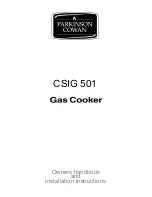
19
MAIN OVEN
The main oven is fitted with a safety device that re-lights the burner if the flame has been extinguished for any reason
and another safety device that reduces the gas flow to a safe level if, for any reason, the burner fails to light.
The oven has different heat zones - the thermostat settings refer to the temperature on the middle shelf; above this
shelf it is hotter and below it is cooler. Two shelves enable full use of the temperatures inside the oven.
The grill pan without the handle can be used in the oven. The maximum size of baking tray that should be used is
300mm x 330mm (12" x 13").
The oven timer offers you the following features:
1. Time of Day
2. Automatic Cooking
3. Minute Minder
AUTOMATIC COOKING
The main oven can be controlled automatically.
GUIDANCE ON AUTOMATIC COOKING
1. Select foods which will take the same time to cook.
2. Set the oven timer so that the food has just finished or is just about to finish cooking on your return to the oven.
This will ensure the food has not cooled down and does not require reheating before serving.
3. Food should be as cold as possible when it goes into the oven, ideally straight from the refrigerator. Frozen meat
and poultry should be thawed thoroughly before it is put in the oven.
4. Warm food should never be placed in the oven if there is to be a delay period. Stews prepared by frying the meat
and vegetables should be cooked as soon as possible.
5. Dishes containing left-over cooked poultry or meat, for example Shepherds Pie, should not be cooked automatically
if there is to be a delay period.
6. Stews and joints should be cooked by the long slow method, so that the delay period is kept to a minimum.
7. On warm days, to prevent harmful bacterial growth in certain foods (ie poultry, joints, etc) the delayed start should
be kept to a minimum.
8. Wine or beer may ferment and cream may curdle during the delay period, so it is best to add these ingredients
just before serving.
9. Foods which discolour should be protected by coating in fat or tossing in water to which lemon juice has been
added, prior to placing food in the oven.
10. Dishes containing liquid should not be filled too full to prevent boiling over.
11. Food should be well sealed (but not airtight) in a container to prevent the loss of liquid during cooking. Aluminium
foil gives a good seal.
12. Ensure food is cooked thoroughly before serving.
TO USE THE OVEN
1.
Check that the timer is set to manual.
2. Place oven shelves in the chosen positions (refer to cooking charts).
3. Push in and turn the control knob fully anti-clockwise. Continue to push in the control knob for at least a further
5 seconds after the gas has lit to allow time for the safety device to operate. If the burner extinguishes when the
control knob is released, repeat the procedure ensuring the control knob is fully depressed and allowing more time for
the safety device to operate.
4. Turn the control knob clockwise to the required setting (refer to cooking chart). There is a
delay of about six seconds whilst the safety device operates before the burner comes on full.
5. To turn off, turn the control knob fully clockwise the the symbol 0.
5. The oven temperature control marking are gas marked 0 to 9.
The equivalent degrees Celsius (sometimes called Centigrade) and degrees Fahrenheit
are shown below as a guide.
Gas Mark
M AIN OVEN
(Cen tre O ven Tem p erature)
C elisus
°C
Fahrenheit °F
S
110
229
1
145
290
2
160
320
3
180
355
•
195
385
Gas Mark
MAIN OVEN
(Centre Oven Temperature)
Celisus
°C
Fahrenheit °F
5
210
410
•
220
430
7
230
445
•
240
465
9
245
475
Never place dishes on the oven base over the burner.
An odour may be noticed when first using the oven - this should cease after a short period of
use.














































